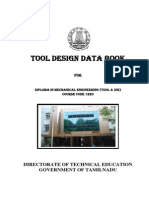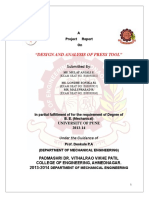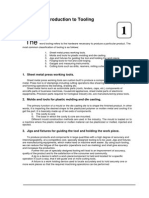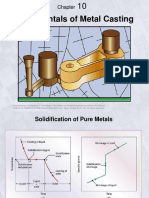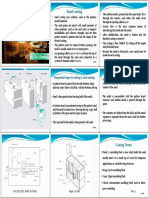Press Tool PDF
Press Tool PDF
Uploaded by
Elaine JohnsonCopyright:
Available Formats
Press Tool PDF
Press Tool PDF
Uploaded by
Elaine JohnsonOriginal Description:
Original Title
Copyright
Available Formats
Share this document
Did you find this document useful?
Is this content inappropriate?
Copyright:
Available Formats
Press Tool PDF
Press Tool PDF
Uploaded by
Elaine JohnsonCopyright:
Available Formats
Types of press tools
Types of press tools
Press tools are commonly used in hydraulic, pneumatic, and mechanical presses to produce components at high
volumes. Generally press tools are categorized by the types of operation performed using the tool, such as blanking,
piercing, bending, forming, forging, trimming etc. The press tool will also be specified as a blanking tool, piercing
tool, bending tool etc.[1]
Classification of press tools
Blanking tool
When a component is produced with one
single punch and die where the entire outer
profile is cut in a single stroke the tool is
called a blanking tool.
Blanking is the operation of cutting flat
shapes from sheet metal.
The outer area of metal remaining after a
Blanking Tool
blanking operation is generally discarded as
waste.
Size of blank or product is the size of the die & clearance is given on punch.
It is a metal cutting operation.
Piercing Tool
Piercing involves cutting of clean holes with a
resulting scrap slug. The operation is called die
cutting and can also produce flat components
where the die, the shaped tool, is pressed into a
sheet material employing a shearing action to cut
holes. This method can be used to cut parts of
different sizes and shapes in sheet metal, leather
and many other materials.
Piercing tool
Cut off tool
Cut off operations are those in which a strip of
suitable width is cut to length in a single
operation. Cut-off tools can produce many parts.
The required length of strip can be cut off for
bending and forming operations using this tool.
Cutoff tool
Types of press tools
Parting off tool
Partings are similar, in that a discrete part is cut from a sheet or strip of metal along a desired geometric path. The
difference between a cutoff and a parting is that a cutoff can be nestled perfectly on the sheet metal, due to its
geometry. With cutoffs, the cutting of sheet metal can be done over one path at a time and there is practically no
waste of material. With partings, the shape can not be nestled precisely. Partings involve cutting the sheet metal
along two paths simultaneously. Partings waste a certain amount of material, that can be significant.
Trimming tool
When cups and shells are drawn from flat sheet metal the edge is left wavy and irregular, due to uneven flow of
metal. This irregular edge is trimmed in a trimming die. Shown is flanged shell, as well as the trimmed ring removed
from around the edge. While a small amount of Material is removed from the side of a component in trimming tool.
Shaving tool
Shaving removes a small amount of material
around the edges of a previously blanked
stampings or piercing. A straight, smooth edge is
provided and therefore shaving is frequently
performed on instrument parts, watch and clock
parts and the like. Shaving is accomplished in
shaving tools especially designed for the
purpose.
Trimming Tool
Bending tool
Bending tools apply simple bends to stampings. A simple bend is done in which the line of the bend is straight. One
or more bends may be involved, and bending tools are a large important class of press tools.
Forming tool
Forming tools apply more complex forms to
work pieces. The line of bend is curved instead
of straight and the metal is subjected to plastic
flow or deformation.
Drawing tool
Drawing tools transform flat sheets of metal into
cups, shells or other drawn shapes by subjecting
the material to severe plastic deformation.
Shown in fig is a rather deep shell that has been drawn from a flat sheet.
Bending Tool
Types of press tools
This type of Press tool is used to perform only
one particular operation therefore classified
under stage tools.
Progressive tool
A progressive tool differs from a stage tool in
the following respect: in a progressive tool the
final component is obtained by progressing the
sheet metal or strip in more than one stage. At
each stage the tool will progressively shape the
component towards its final shape, with the final
stage normally being cutting-off.
Drawing Tool
Compound tool
The compound tool differs from progressive and stage tools by the arrangement of the punch and die. It is an
inverted tool where blanking and piercing takes place in a single stage and also the blanking punch will act as the
piercing die.
Combination tool
In a combination tool two or more operations such as bending and trimming will be performed simultaneously. Two
or more operations such as forming, drawing, extruding, embossing may be combined on the component with
various cutting operations like blanking, piercing, broaching and cut off takes place- it can perform a cutting and non
cutting operations in a single tool.
General Press tool Construction
The general press tool construction will have following elements:
Shank: It is used to locate the press tool in press for alignment purpose.
Top Plate: It is used to hold top half of the press tool with press slide.
Punch Back Plate : This plate prevents the hardened punches penetrating into top plate.
Punch Holder: This plate is used to accommodate the punches of press tool.
Punches : To perform cutting and not cutting operations either plain or profiled punches are used.
Die Plate: Die plate will have similar profile of the component where cutting dies usually have holes with land
and angular clearance and non cutting dies will have profiles.
Die Back Plate:This plate prevents the hardened Die inserts penetrating into bottom plate.
Guide Pillar & Guide Bush : Used for alignment between top and bottom halves of the press tools.
Bottom plate:It is used to hold bottom half of the press tool with press slide.
Stripper plate: it is used to strip off the component from punches.
strip guides: It is used to guide the strip into the press tool to perform the operation.
Types of press tools
Cutting force in Press tool
In general cutting force (CF) can be calculated
using formula: CF =L x S x max
cutting force will be in Newton(N) Where, L =
Cut length in mm,(perimeter of profile to be cut)
Ex: 40 mm square to be cut will have cut length
of 160 mm
S = Sheet metal thickness in mm,
max = Maximum shear strength of sheet metal
MPa
Stripping Force
Press tool
Stripping force will be usually 10 to 20 % of
cutting force.
Press Force
Press force will be cutting force with stripping force Press Force = Cutting force + Stripping force
Fits in Press Tools
Punch holder and Punches =H7/k6
Punch and Stripper = H7/g6
Guide Pillar and Guide bush = H7/g6
Guide bush and Top plate = H7/p6
Guide pillar and bottom plate = H7/p6
Dowel and plate = H7/m6
References
[1] Cyril Donaldson, George H LeCain, V C Goold, Tool design 3rd edition, Tata McGraw-Hill Education, New Delhi.
Article Sources and Contributors
Article Sources and Contributors
Types of press tools Source: http://en.wikipedia.org/w/index.php?oldid=622315518 Contributors: 220 of Borg, Alan Liefting, Altar, AsceticRose, Biscuittin, DoctorKubla, Ekabhishek,
Gravuritas, HMSSolent, JaconaFrere, Jim1138, Katharineamy, KylieTastic, Magioladitis, Mild Bill Hiccup, Penfold20, Pinethicket, PrabhakarPurushothaman, Rasika251, Rich Farmbrough,
SchreiberBike, Vieque, 37 anonymous edits
Image Sources, Licenses and Contributors
File:Blanking Tool.png Source: http://en.wikipedia.org/w/index.php?title=File:Blanking_Tool.png License: Creative Commons Zero Contributors: PrabhakarPurushothaman, Sfan00 IMG
File:Piercing tool.png Source: http://en.wikipedia.org/w/index.php?title=File:Piercing_tool.png License: Creative Commons Zero Contributors: PrabhakarPurushothaman, Sfan00 IMG
File:Cutoff tool.png Source: http://en.wikipedia.org/w/index.php?title=File:Cutoff_tool.png License: Creative Commons Zero Contributors: PrabhakarPurushothaman, Sfan00 IMG
File:Trimming Tool.png Source: http://en.wikipedia.org/w/index.php?title=File:Trimming_Tool.png License: Creative Commons Zero Contributors: PrabhakarPurushothaman, Sfan00 IMG
File:Bending_tool.png Source: http://en.wikipedia.org/w/index.php?title=File:Bending_tool.png License: Creative Commons Zero Contributors: PrabhakarPurushothaman, Sfan00 IMG
File:Drawing_tool.png Source: http://en.wikipedia.org/w/index.php?title=File:Drawing_tool.png License: Creative Commons Zero Contributors: PrabhakarPurushothaman, Sfan00 IMG
File:Press_tool.png Source: http://en.wikipedia.org/w/index.php?title=File:Press_tool.png License: Creative Commons Zero Contributors: PrabhakarPurushothaman, Sfan00 IMG
License
Creative Commons Attribution-Share Alike 3.0
//creativecommons.org/licenses/by-sa/3.0/
You might also like
- Punch and DieDocument16 pagesPunch and DieNani DatrikaNo ratings yet
- Presentation On Press Tool Design 01Document55 pagesPresentation On Press Tool Design 01Anonymous pMVR77x185% (34)
- Press Tool Operation and FunctionsDocument25 pagesPress Tool Operation and Functionsjagan89% (9)
- Press Tool Design PPT Module 1Document48 pagesPress Tool Design PPT Module 1janak100% (1)
- Selection of Material and Hardware Used in Press ToolDocument22 pagesSelection of Material and Hardware Used in Press ToolVipul Meta100% (1)
- Press Tool Master FileDocument196 pagesPress Tool Master FileIrwan Rony86% (80)
- Press Tool DesignDocument36 pagesPress Tool DesignAmar Bhopi100% (2)
- Tool DesignDocument1 pageTool DesignvinodNo ratings yet
- Design of Jigs and FixturesDocument3 pagesDesign of Jigs and FixturesRajueswarNo ratings yet
- Design and Calculations of Piercing & Blanking DieDocument89 pagesDesign and Calculations of Piercing & Blanking DieVipul MetaNo ratings yet
- Tool Design Press Tool Design 1 x1Document86 pagesTool Design Press Tool Design 1 x1jacky hansdah100% (2)
- Tool Design Data Book PDFDocument124 pagesTool Design Data Book PDFbmvinay74% (19)
- Stoppers: Stop PositionDocument44 pagesStoppers: Stop PositionSubodh KumarNo ratings yet
- Report Press ToolDocument61 pagesReport Press ToolAvinash BorgaonkarNo ratings yet
- Press Tool-IgtrDocument176 pagesPress Tool-IgtrVedang Kulkarni100% (5)
- Elements of Press Tool: Base PlateDocument3 pagesElements of Press Tool: Base PlateSujay Avati100% (1)
- Strip LayoutDocument35 pagesStrip LayoutJay PatelNo ratings yet
- Die Design Deep Drawing ReportDocument24 pagesDie Design Deep Drawing ReportSerkan Batı100% (4)
- 4 Deep DrawingDocument26 pages4 Deep Drawingmck_medo100% (1)
- Unit-4 Sheet Metal ProcessDocument39 pagesUnit-4 Sheet Metal ProcessKarthikeyan Murugananthan100% (6)
- 5 Strip LayoutDocument28 pages5 Strip LayoutNarendrareddy Ramireddy67% (3)
- Press Tool TechnologyDocument104 pagesPress Tool TechnologythirumalaikumaranNo ratings yet
- Tool & Die Design Lecture Jan2011 13mar12Document100 pagesTool & Die Design Lecture Jan2011 13mar12azizmaarof100% (8)
- Core Cavity ExtractionDocument159 pagesCore Cavity ExtractionSaggam NarasimharajuNo ratings yet
- Press Tool Theory - 1Document144 pagesPress Tool Theory - 1Abhishek AbhiNo ratings yet
- Conceptual Design of Blanking Tool For Washer Special: Nandish Harti DR D. RamegoudaDocument4 pagesConceptual Design of Blanking Tool For Washer Special: Nandish Harti DR D. Ramegoudaaravindan476No ratings yet
- Progressive Die DesignDocument56 pagesProgressive Die DesignHesham Yasin100% (2)
- Press ToolDocument12 pagesPress ToolJitendra Bhole100% (2)
- Press Tool-1 PDFDocument71 pagesPress Tool-1 PDFajay100% (1)
- Tool and Die Design NotesDocument23 pagesTool and Die Design NotesAnand Karn Ak100% (1)
- Tool and Die QuestionsDocument8 pagesTool and Die QuestionsKishan SahuNo ratings yet
- Project Report: Design of Mould & Press ToolDocument67 pagesProject Report: Design of Mould & Press ToolBharat SinghNo ratings yet
- Press Tools'Document241 pagesPress Tools'kannan83% (6)
- Igtr Aurangabad Curriculum PDTD&CC 08Document31 pagesIgtr Aurangabad Curriculum PDTD&CC 08सचिन पटेलNo ratings yet
- Press Tool ReportDocument40 pagesPress Tool ReportIshu Bassan100% (2)
- Tool Engineering PDFDocument3 pagesTool Engineering PDFEr Nikunj Miyani75% (4)
- Selection of Presses and Its SettingDocument21 pagesSelection of Presses and Its SettingVipul MetaNo ratings yet
- Tool Design Theory (DCD)Document252 pagesTool Design Theory (DCD)Bhavsar Chirag100% (1)
- Sheet Metal OperationsDocument22 pagesSheet Metal OperationsParveen Saini0% (1)
- Press Tool CalculationDocument2 pagesPress Tool CalculationSunil Mandalathe60% (5)
- Sheet Metal SpringbackDocument6 pagesSheet Metal SpringbackVipul AgrawalNo ratings yet
- Bending Die DesignDocument46 pagesBending Die DesignSujit Mule83% (6)
- Lab10 Final Progressive Die PDFDocument7 pagesLab10 Final Progressive Die PDFSyed Asif Bukhari100% (1)
- Design Study of Progressive Tool DesignDocument34 pagesDesign Study of Progressive Tool Designsudheer9289% (9)
- 01 Ih - Stamping FundamentalsDocument24 pages01 Ih - Stamping FundamentalsDiego AcostaNo ratings yet
- Press Tool TechDocument48 pagesPress Tool Technikhil sidNo ratings yet
- Types of Press Tools - Wikipedia PDFDocument24 pagesTypes of Press Tools - Wikipedia PDFAvula Vinay100% (1)
- Types of Press Tools: January 2012Document6 pagesTypes of Press Tools: January 2012Shubham RenakeNo ratings yet
- Design ToolDocument14 pagesDesign ToolAnonymous pMVR77x1No ratings yet
- Press ToolDocument6 pagesPress Toolashok v jainNo ratings yet
- Types of Press Tools: January 2012Document6 pagesTypes of Press Tools: January 2012Vasanth MNo ratings yet
- PressDocument4 pagesPressPra VeeNo ratings yet
- PSJ MetalsDocument15 pagesPSJ Metalsajaysurya9245No ratings yet
- 01 Introduction To Press ToolsDocument9 pages01 Introduction To Press ToolsAngelo De DominicisNo ratings yet
- Course Conducted For PgditdDocument30 pagesCourse Conducted For Pgditdਹਰਪ੍ਰੀਤ ਸਿੰਘNo ratings yet
- 01 Introduction To Press ToolsDocument742 pages01 Introduction To Press Toolsswapnilnevewani15No ratings yet
- Production Engineering NotesDocument63 pagesProduction Engineering NotesShaheer KhalidNo ratings yet
- Modeling and Simulation For: EveryoneDocument38 pagesModeling and Simulation For: EveryoneElaine JohnsonNo ratings yet
- Magnesium With HariDocument9 pagesMagnesium With HariElaine JohnsonNo ratings yet
- Ltu Lic 0596 Se PDFDocument61 pagesLtu Lic 0596 Se PDFElaine JohnsonNo ratings yet
- AI Applications To Metal Stamping Die Design A Review PDFDocument7 pagesAI Applications To Metal Stamping Die Design A Review PDFElaine JohnsonNo ratings yet
- ADMET Sheet Metal Testing Guide July 2013Document9 pagesADMET Sheet Metal Testing Guide July 2013Elaine JohnsonNo ratings yet
- Taper BlankDocument13 pagesTaper BlankElaine JohnsonNo ratings yet
- 17 - AHSS Forming Simulation For Shear Fracture and Edge Cracking PDFDocument37 pages17 - AHSS Forming Simulation For Shear Fracture and Edge Cracking PDFElaine JohnsonNo ratings yet
- Fast&Accurate AutosetupDocument6 pagesFast&Accurate AutosetupElaine JohnsonNo ratings yet
- BSE Tip Curve Binder With SheetDocument5 pagesBSE Tip Curve Binder With SheetElaine JohnsonNo ratings yet
- PDFDocument11 pagesPDFElaine JohnsonNo ratings yet
- Hot Forming IntroductionDocument19 pagesHot Forming IntroductionElaine JohnsonNo ratings yet
- Integrated Process Simulation and Die-Design in Sheet Metal FormingDocument4 pagesIntegrated Process Simulation and Die-Design in Sheet Metal FormingElaine JohnsonNo ratings yet
- Sheet Metal Forming ProcessesDocument38 pagesSheet Metal Forming ProcessesRavichandran GNo ratings yet
- Chapter 11-Casting IIDocument80 pagesChapter 11-Casting IIaff123051No ratings yet
- Lab 6-OUR Casting LAB - W2022Document7 pagesLab 6-OUR Casting LAB - W2022usmanNo ratings yet
- Module 5 - Principles of Gating and RiseringDocument14 pagesModule 5 - Principles of Gating and RiseringGoutham ReddyNo ratings yet
- Comandos de Autocad en 5 Idiomas: MagisterDocument26 pagesComandos de Autocad en 5 Idiomas: MagisternelsaguiNo ratings yet
- US20190217380A1Document14 pagesUS20190217380A1CideAmeteBerengueliNo ratings yet
- Sheet Metal OperationsDocument63 pagesSheet Metal OperationsDilip ShenoyNo ratings yet
- Sheet Metal Forming PDFDocument9 pagesSheet Metal Forming PDFRakhesh Manchi100% (1)
- Dr. Ahmed Khalifa Ahmed - Khalifa@mhiet - Edu.egDocument46 pagesDr. Ahmed Khalifa Ahmed - Khalifa@mhiet - Edu.egØŠMÄÑ MØHÂMĒDNo ratings yet
- Ch07 HW QuestionsDocument2 pagesCh07 HW QuestionsSirilak KlakwongNo ratings yet
- Inherent: They Are Usually Related To Discontinuities Found in TheDocument10 pagesInherent: They Are Usually Related To Discontinuities Found in TheBhadresh PatelNo ratings yet
- ENSC3002: Manufacturing and Materials: Lecture 2: Casting IntroductionDocument30 pagesENSC3002: Manufacturing and Materials: Lecture 2: Casting IntroductionRoger HanNo ratings yet
- Chapter 20-Sheet MetalworkingDocument72 pagesChapter 20-Sheet MetalworkingMuhammad Qasim Qureshi100% (1)
- TC Excel SheetDocument16 pagesTC Excel SheetVasudev DabholkarNo ratings yet
- RMK Group A4 PPT MT-I (UNIT-I)Document82 pagesRMK Group A4 PPT MT-I (UNIT-I)Rajmchz100% (1)
- Report About Casting DefectsDocument6 pagesReport About Casting DefectsAbdul Rehman FaisalNo ratings yet
- 02 - Ch10 - Fundamentals of Metal CastingDocument31 pages02 - Ch10 - Fundamentals of Metal CastingFaiq Sina Alfain100% (1)
- Pipes - Below - 405 - With - Benddies - in Detail PDFDocument1 pagePipes - Below - 405 - With - Benddies - in Detail PDFnikhiljith o uNo ratings yet
- ME 2201 - Manufacturing Technology-IDocument147 pagesME 2201 - Manufacturing Technology-IMahendra Babu MekalaNo ratings yet
- Bulk Deformation ProcessDocument33 pagesBulk Deformation ProcessADARSH KUMARNo ratings yet
- Microsoft PowerPoint - 5-Sheet MetalworkingDocument26 pagesMicrosoft PowerPoint - 5-Sheet MetalworkingRama SatriotamaNo ratings yet
- Casting, Rolling, Forging, ExtrusionDocument60 pagesCasting, Rolling, Forging, ExtrusionHARIKRISHNAN SRNo ratings yet
- GE105-Metal Casting Experiment - Introduction Before The Practical-Lab ClassDocument26 pagesGE105-Metal Casting Experiment - Introduction Before The Practical-Lab ClassBabong KobNo ratings yet
- S04-Types of DiesDocument13 pagesS04-Types of Diesladyinred90No ratings yet
- Metal Casting Processes: Qualitative ProblemsDocument12 pagesMetal Casting Processes: Qualitative ProblemsdiegoNo ratings yet
- Cores, Chaplets and Chills: AdditivesDocument10 pagesCores, Chaplets and Chills: AdditivesGandi GahanNo ratings yet
- FoundryDocument2 pagesFoundryHafiz UdinNo ratings yet
- Metal Casting Process (Engineering Workshop)Document35 pagesMetal Casting Process (Engineering Workshop)Vaibhav GoyalNo ratings yet
- Casting, Welding, Machine Tools, Material SC PDFDocument240 pagesCasting, Welding, Machine Tools, Material SC PDFSanjay Kajal0% (1)
- Press Tool TechnologyDocument4 pagesPress Tool TechnologyErzan FauzanNo ratings yet












